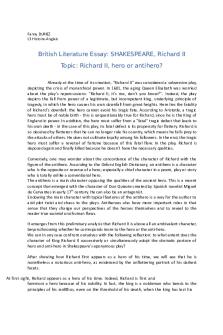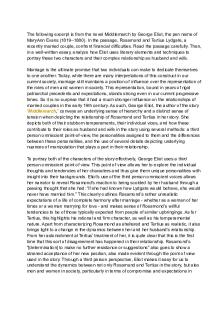Macro practice essay - Richard Kneller PDF

| Title | Macro practice essay - Richard Kneller |
|---|---|
| Author | Anya Corvesor |
| Course | Macroeconomic Theory |
| Institution | University of Nottingham |
| Pages | 4 |
| File Size | 174.2 KB |
| File Type | |
| Total Downloads | 27 |
| Total Views | 147 |
Summary
Richard Kneller...
Description
As a consequence of the policy of austerity undertaken in the UK since 2010 alongside the perpetuation of the idea of ‘benefit scroungers’ in the popular press, the reservation wage of workers has fallen. Using a new Keynesian model of the macroeconomy describe the effects of a fall in the reservation wage. Describe an appropriate macroeconomic stabilisation policy in response to this change. As a result of the austerity program by the UK government that saw a reduction in the level of benefits, it is estimated that 330,000 children will be adversely affected (Butler and Arnet 2015). There is also a negative connotation of people on benefits due to the perpetuation of the idea of ‘benefit scroungers’ in the press. This has caused parents and people in general to have no choice but to decrease their reservation wages as a result of workers bargaining power has reduced. Workers no longer have benefits to fall back on; so have no choice but to find a job. They are more willing to take a job for a smaller wage, equating a fall in the reservation wage. When benefits are removed it is estimated that the reservation wage falls on average by 15% (Fishe 1982). The reservation wage is defined by Brown and Taylor (2013) as ‘the lowest wage at which an individual is willing to work’. Using the dynamic AD-AS model it will be shown that a decrease in the reservation wage will lead to a decrease in the natural rate of unemployment.
In the dynamic AD-AS model, various assumptions are made in order to be able to model the economy. On the demand side of the model, there are the goods and money market. In the goods market it is assumed consumption depends on the growth of disposable income and investment depends on growth of income and the real interest rate. Both consumption and investment consider the growth of a variable in order to account for changes over time. Also, assume government expenditure and taxation are both exogenous. Assumed to be in a closed economy as to only consider the effect of the UK economy, therefore the exchange rate is not considered. In the money market, money demand is assumed to be based on the choice between money and bonds only. Money supply is assumed as exogenous and the growth rate of money supply is positive in the medium run.
On the supply side of the model, it is assumed in the production function that there is only one output and technological change – which is positive and constant. The output depends solely on labour which has constant returns to scale. Labour is also not constant, the natural rate of unemployment in the labour market is determined by the interaction of the wage setting and price setting equations. The wage setting equation demonstrates a negative relationship between the expected real wage and the unemployment rate. The price setting equation shows that the price setting decisions determine the real wage paid by the firms. Lastly it is assumed that expectations of inflation are fixed in the short run, the expectations-augmented Philips curve will be used, so it is assumed that π te =θ π t−1 .
As a consequence of the policy of austerity and the idea of benefit scroungers thereby reducing the unemployment benefits, workers reservation wage has fallen. This in turn causes the allencompassing variable z in the wage setting equation
W =f (u , z ) to fall and therefore the wage PE
setting equation shifts to the left. As seen, the natural rate of unemployment subsequently decreases as more workers are willing to work at the given real wage. This then enters the dynamic AD-AS model through decreasing the Philips curve equation, π t−π t −1 =−α ( ut −un ) . The Philips curve shows the relates the changes in inflation to unemployment. Because the natural rate of unemployment, un has decreased, the change in inflation ( π t−π t −1 ) must also decrease so the current inflation rate, π t , must decrease in the short run. This subsequently effects the aggregate demand equation: gyt = gmt – π t + DSt, which relates the change in unemployment to output growth. As inflation has fallen and there have been no demand shocks (DSt) or effects to the growth rate of money (gmt) the growth rate of output (gyt ) decreases. As Okun’s law, ut −ut −1 =−β ( g yt −¿ g´ y ) relates the change in unemployment to output growth it is affected. The decrease in the growth rate of output causes the current unemployment rate to decrease. Furthermore, the increase in inflation acts as an increase in price at a given time, so on the IS-LM diagram at time t, the LM curve shifts to the left. This increases the nominal interest rate which increases the real interest rate as expectations of inflation are fixed in the short run which can be seen from
e r t ≈ it −π t+1 .
As time goes on, the current unemployment rate becomes equal to the new natural rate of unemployment, which causes the inflation rate to return to the previous medium run equilibrium value. This in turn makes the growth rate of output return to its original rate. Overall, the natural rate of unemployment in the medium run is lower than before but the growth rate of output, the growth rate of money and inflation all return to the previous medium run equilibrium level.
An appropriate macroeconomic stabilisation policy would be an expansionary monetary policy. A permanent increase in nominal money growth according to the Fisher hypothesis will lead to a onefor-one increase in the nominal interest rate and inflation. Consider r t ≈ it −π et+1 where r t is the real interest rate,
it is nominal interest rate and π te+1 is the expected inflation rate at time
t+1. In the IS-LM diagram at time t, an increase in money growth causes an increase in the nominal interest rate. It is assumed that monetary policy will not affect the real interest rate so this will
remain constant, therefore expected inflation rate must also increase by the same amount as the nominal interest rate. Given this increase in the inflation rate, according to the aggregate demand equation, the growth rate of output will decrease. Consequently, increasing the current rate of unemployment through Okun’s law. This will mean that the adjustment to the lower natural rate of unemployment is slower; thereby stabilising the macroeconomy.
The dynamic AD-AS model assumes there are adaptive expectations, however the Lucas critique argues that it is unrealistic to assume that wage seters would not consider changes in policy when forming their expectations. Wage seters will include their future expectations of inflation into their decision, supported in Batini et al (2005) which found ‘inflation appears to be highly forwardlooking’. It is important to note though in this paper the UK is taken to be an open economy so is differing from the model. This is relevant as increasing money growth to counteract the decreased unemployment relies on the fact that inflation increases. However according to the Lucas critique, if wage seters were convinced that inflation will rise, they would accordingly increase their expectations of inflation which would in turn increase actual inflation, without any change in the unemployment rate. Consequently making the macroeconomic stabilization policy suggested ineffective. Furthermore, it also assumed that expectations of inflation are formed by the previous rate of inflation, whereas under rational expectations the unemployment rate equals its natural rate at any time t. This is significant as under rational expectations the trade-off between inflation and unemployment is removed, meaning that an increase in the growth rate of money supply will not affect unemployment only inflation. Once again, the macroeconomic stabilization policy of increasing money growth to slow the transition to a lower natural rate of unemployment would be ineffective.
Overall, it is clear that the decrease in the benefits available had some positive effects as it led to a decrease in the natural rate of unemployment which would increase welfare for the UK. However, there were some negative effects that accompanies an increase in the reservation wage. The nominal interest rate increased, which can be undesirable as higher interest rates increases the cost of borrowing, potentially deterring investment. If the assumptions of the model are altered then the results can change dramatically. Therefore, the simplifying assumptions made may invalidate the results and the real data may show another effect.
Bibliography BATINI, N. JACKSON, B. NICKELL, S. An open-economy new Keynesian Phillips curve for the U.K. Journal of Monetary Economics. September 2005, Vol52 (Issue 6), pp. 1061-1071. Available from: htps://www.sciencedirect.com/science/article/pii/S0304393205000747? casa_token=fC9aSomg6msAAAAA:T6Xo0PBPBqQTI96mJX0tWqkbGCQL4vQRrokHueH5GP5SVHzsGUP qxVKbe5a1YiB0A7fgOTnB BROWN, S. TAYLOR, K. Reservation wages, expected wages and unemployment. Economics Leters. 2013, Vol119 (Issue 3), pp. 276-279. Available from: htps://www.sciencedirect.com/science/article/pii/S0165176513001055 BUTLER, P. ARNETT, G. 2015. Benefits cap to hit huge number of children, government figures show. The Guardian. 20 July
FISHE, R. Unemployment Insurance and the Reservation Wage of the Unemployed. The Review of Economics and Statistics. February 1982, Vol64, pp. 12-17. Available from: htps://www.jstor.org/stable/1937938...
Similar Free PDFs

Dartnall Richard Essay 2
- 6 Pages

Essay Richard II
- 6 Pages

ACER-Gamsat-Practice Essay practice
- 60 Pages

Macro
- 5 Pages

Macro
- 2 Pages

Advanced Practice Essay
- 3 Pages

Practice Essay - Rewrite
- 2 Pages

Kernel Essay Practice
- 1 Pages

Practice essay - Grade: B
- 2 Pages

Narrative Essay Practice pt
- 5 Pages

Station Eleven Practice Essay
- 2 Pages
Popular Institutions
- Tinajero National High School - Annex
- Politeknik Caltex Riau
- Yokohama City University
- SGT University
- University of Al-Qadisiyah
- Divine Word College of Vigan
- Techniek College Rotterdam
- Universidade de Santiago
- Universiti Teknologi MARA Cawangan Johor Kampus Pasir Gudang
- Poltekkes Kemenkes Yogyakarta
- Baguio City National High School
- Colegio san marcos
- preparatoria uno
- Centro de Bachillerato Tecnológico Industrial y de Servicios No. 107
- Dalian Maritime University
- Quang Trung Secondary School
- Colegio Tecnológico en Informática
- Corporación Regional de Educación Superior
- Grupo CEDVA
- Dar Al Uloom University
- Centro de Estudios Preuniversitarios de la Universidad Nacional de Ingeniería
- 上智大学
- Aakash International School, Nuna Majara
- San Felipe Neri Catholic School
- Kang Chiao International School - New Taipei City
- Misamis Occidental National High School
- Institución Educativa Escuela Normal Juan Ladrilleros
- Kolehiyo ng Pantukan
- Batanes State College
- Instituto Continental
- Sekolah Menengah Kejuruan Kesehatan Kaltara (Tarakan)
- Colegio de La Inmaculada Concepcion - Cebu




